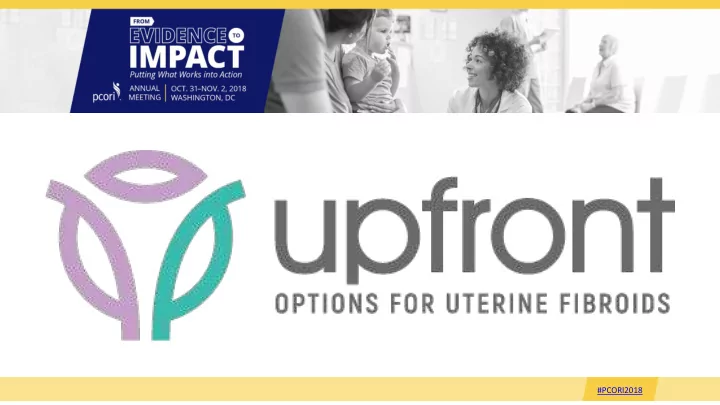

#PCORI2018
A multi-component implementation of shared decision making for uterine fibroids treatment Glyn Elwyn BA MD MSc PhD FRCGP Professor @glynelwyn #PCORI2018 #PCORI2018
Background • About 50% of women of reproductive age “We will include new comparative have fibroids, half with symptoms effectiveness evidence about uterine fibroid treatments into a shared • Related symptoms substantially impair decision making implementation quality of life and can cause higher healthcare costs strategy ...” Shared decision making helps because “We will use encounter patient treatments have different burdens and decision aids - Option Grids TM - that consequences, e.g. work loss, impact on have substantial proof of fertility, so the choice of options is sensitive to effectiveness across many practice individual preferences settings ... ” 3
PCORI Evidence PI Velentgas Procedure *n=3547 **n=8687 Options Contract CE-12-11-4430 Hysterectomy 78% 70% Fibroid treatment procedure volumes Endometrial 15% 15% ablation > 500 institutions, Jan 2005 - Dec 2011 Myomectomy 7% 12% Uterine artery 1% 3% embolization COMPASS COMparative effectiveness and PAtient Safety and Surveillance * Q-EMR=Quintiles Electronic Medical Record System ** 4
1 Team talk Work together , describe Let’s work as a team choices, offer support, to make a decision that and ask about goals suits you best Active listening 3 Paying close attention 2 and responding accurately Option talk Decision talk Deliberation Discuss alternatives Get to informed Thinking carefully about using risk preferences, make options when facing a decision communication preference-based principles decisions Tell me what matters Let’s compare the most to you for this possible options decision 5
Consolidated Framework for Implementation Research (Laura Damschroder) & Normalization Process Theory (Carl May) Multicomponent SDM Approach Measuring organizational Clinical & System Level Effects Patient Level Effects readiness in order to address clinical & system-level factors Tailored SOM training Intervention uptake (primary Implementation Increased shared decision adapted to contextual outcome) Sustainability making preferences Sustained use High fidelity of SOM approach Reduced symptom scores beyond active Option Grid: Picture, text and Perceived high utility of tools implementation Reduced financial toxicity online versions used in the Reduced healthcare utilization clinic visit Differences in treatment Normalization achieved (NPT choices Integration of SDM approach evaluation) & new evidence into existing clinical practice guidelines 6
Option Grid TM encounter patient decisionaids • Meet Washington State Certification Criteria, based on International Patient Decision Aids Standards (IPDAS) • Produced by EBSCO Health using DynaMed Plus Evidence System Adaptations • Maintained in English and Spanish Patient Questions Endometrial ablation Hysterectomy • New Picture Option Grid version What does the An instrument will be used to remove You will have surgery to remove your treatment involve? the lining of your uterus using heat, or uterus. You will stay in the hospital for 1 • Printed and online versions cold, or microwave energy. This takes to 2 days. It may take up to 6 weeksto less than an recover. Discuss costs. • Integrated into EHRs where feasible hour and you usually go home the same day. Discuss costs. Will I bleed less? Out of 100 women 1 year after You will stop getting your period, but you endometrial ablation, up to: may have spotting for the first few • 63 (63%) stop getting their period months • 93 (93%) no longer need extra pads/tampons when they get a period • 100 (100%) go about usual activities without bother from heavy bleeding during their period. 7
Five implementation settings Montefiore Medical Center, Bronx, NY (n=1,000) Mayo Clinic, Rochester, MN (n=500) Barnes-Jewish Hospital, St. Louis, MI (n=300) Brigham and Women’s, Boston, MA (n=700) Dartmouth-Hitchcock Medical Center, Hanover, NH (n=100) 8
Implementation Strategy & Patient-Centered Outcome Measures Contextual & Implementation Evaluation Patient Outcomes & Characteristics Organizational readiness ( MORE ) UFS-QOL (symptom scale) Clinician attitudes to PDAs ( ADOPT ) collabo RATE Intervention fidelity using Observer OPTION-5 Financial toxicity measure ( COST ) % of eligible patients receiving intervention Resource utilization (ambulatory & hospital) Utility of tools and approach (clinician interviews) Intended / received treatment Normalization Process Theory NOMAD Toolkit Health literacy ( Chew ), insurance & demographics We estimate approximately 30% of patients will complete surveys ( n=800 ) 9
Patient and Stakeholder Roles • Community Advisory Board (CAB) Stakeholder Partners ACOG & Primary Care Engagement Participatory research approach - with Priscilla Velentgas (Stakeholder Partnership Tina Foster (ACOG) quarterly meetings of stakeholders and Council) patient partners to discuss progress Nan Cochran (Primary Care Two implementation experts Practitioner) − Trudy van der Weijden − Rachel Thompson • Implementation Steering Group Five Patient Partners Site Readiness Quarterly meeting of all project members including consultants, patient Including Directors: Measure of Organizational Readiness completed by: and stakeholder partners, and invited National Uterine Fibroids CAB representative Foundation 11 stakeholders at each site (n=55) The Fibroid Foundation 10
Questions? 11
Thank You Glyn Elwyn @glynelwyn #PCORI2018 12
Recommend
More recommend